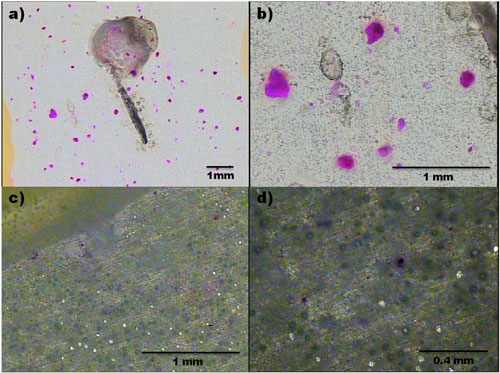| Posted: Sep 30, 2013 | |
Nanotechnology approach to corrosion sensing coatings |
|
| (Nanowerk Spotlight) Due to the massive economic impact of corrosion degradation on metallic structures, the area of active protective coatings has been developed very fast in the past few years. The goal is to significantly reduce the maintenance costs in many industrial applications by applying active sensing coatings. The indication of corrosion activity by these coatings will allow optimization of the maintenance operations avoiding excessive unnecessary preventive operations in the cases when coating is still able to protect the metallic structures. | |
| Different strategies for creation of self-healing coatings have been suggested. In a previous Nanowerk Spotlight, for instance, we reported on self-healing nanotechnology anticorrosion coatings as alternative to toxic chromium. We followed that up with a report on a novel and effective system for metal protection against a wide range of biological and chemical aggressive agents ("Protecting metal surfaces with a novel nanoengineered encapsulation system"). | |
| Today we look at a novel sensing active coating on the basis of nanocapsules containing pH-indicating agent. The main idea of this work by a research team from the University of Aveiro in Portugal, is to create a novel active protective coating which is able to indicate when corrosion processes start under the coatings or in different defects. | |
| The nanoreactors being introduced in the coating change their color in the zones where corrosion processes start. An important feature of these nanoreactors is that the indicating molecules are not released from the mesoporous nanocarriers, thereby preventing spontaneous leaching and ensuring long service time. | |
 |
|
| Scheme of pH sensing response from coating. (© IOP Publishing) | |
| The team, led by Mikhail Zheludkevich, a senior researcher at the university's Department of Materials and Ceramics Engineering, CICECO, published their findings in the September 17, 2013 online edition of Nanotechnology ("Nanocontainer-based corrosion sensing coating"). | |
| "The corrosion sensing can be considered as independent functionality of a protective coating or can also be considered as an important additional functionality which can complement the self-healing coatings," Zheludkevich tells Nanowerk. "For example, the new coating developed by our group in collaboration with several European partners from academic and industrial sectors is counting on the multi-level self-healing effect based on 'smart' nanocontainers. The main idea is that several mechanisms of self-healing can be integrated in the same coating providing effective active protection which is proportional to the external impacts such as corrosive attack and mechanical impacts. | |
| In such a coating, the active healing agents responsible for different mechanisms are encapsulated in micro- or nano-containers and then integrated into the polymer coating. Different nanocontainers can introduced to different layers of the coating or can be used in a single layer system. | |
 |
|
| Pictures of coated substrates doped with Si NC–PhPh and tested during 3 days in 0.5 M NaCl: (a) and (b) coated aluminium alloy with artificial scribe, (c) and (d) coated magnesium alloy without scribe. (© IOP Publishing) | |
| These coatings were developed in the frame of large-scale European project MUST ('Multi-Level Protective Materials for Vehicles by 'Smart' Nanocontainers'). | |
| In their work, the team encapsulated phenolphthalein – a colorless crystalline solid often used as an acid-base indicator – in mesoporous silica nanocontainers. | |
| "With the onset of corrosion, pH increases in the local cathodic areas due to the formation of hydroxide ions whilst acidification often occurs at anodic sites as a result of hydrolysis reactions," explains Zheludkevich. "The respective pH variations can be used to detect and locate the active corrosion spots in confined defects of the coatings or under the coatings if pH indicators are incorporated in a polymer protective layer." | |
| The main idea of the team was to provide a color change signal as a result of pH change in the vicinity of a nanocontainer with consecutive diffusion of hydroxide ions into the mesopores reacting with pH indicator within the container. | |
| As Zheludkevich points out, the introduction of corrosion sensing functionality to the self-healing coating is an important step which allows detecting the moment when the coating is not able to heal the defects anymore and an external intervention is needed to avoid an extensive corrosive damage. | |
| One challenging future direction for this research area is the integration of several functionalities into the protective coatings. The objective would be to develop coatings which not only integrate several self-healing mechanisms at the same time but also provide additional self-monitoring tasks with optional antibacterial or antifouling functionalities. | |
 By
Michael
Berger
– Michael is author of three books by the Royal Society of Chemistry:
Nano-Society: Pushing the Boundaries of Technology,
Nanotechnology: The Future is Tiny, and
Nanoengineering: The Skills and Tools Making Technology Invisible
Copyright ©
Nanowerk LLC
By
Michael
Berger
– Michael is author of three books by the Royal Society of Chemistry:
Nano-Society: Pushing the Boundaries of Technology,
Nanotechnology: The Future is Tiny, and
Nanoengineering: The Skills and Tools Making Technology Invisible
Copyright ©
Nanowerk LLC
|
|
|
Become a Spotlight guest author! Join our large and growing group of guest contributors. Have you just published a scientific paper or have other exciting developments to share with the nanotechnology community? Here is how to publish on nanowerk.com. |
|
